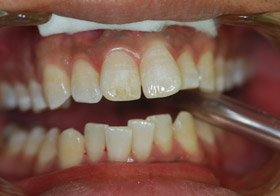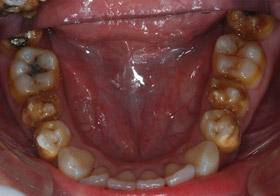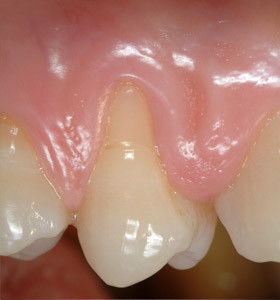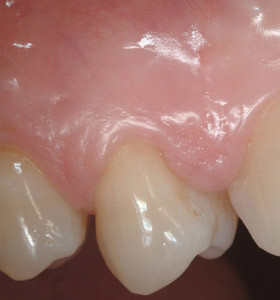Are teeth ever naturally white?
Teeth are not naturally pure white in most people.
The colour of our teeth is determined by (a) the composite colour of all the structures that make up the tooth – the outer layer of enamel, the inner layer of dentine as well as the pulp which contains the nerve as well as (b) how light is absorbed and reflected off these structures.
Enamel is whiter, while dentine has a naturally yellow tinge. There is also a natural gradation of colour – darker nearer the gum margin and lighter at the tip of the teeth. This variation is affected by the thickness and translucency of the enamel and dentine. Typically, the canines at the corner of the mouth are darker than the front teeth and teeth also tend to become darker with age.
Some common factors influencing the colour of our teeth include:
- Extrinsic stains caused by coffee; tea; smoking, and certain mouthrinses.
- Tooth decay; poor oral hygiene; gum recession; failing restorations/fillings as well as trauma.
- Exposed dentine as well as wear affecting the thickness and translucency of the enamel ie its ability to camouflage the yellowish underlying dentine.
- Developmental defects affecting the enamel or underlying dentine either congenitally e.g. amelo / dentinogenesis imperfecta or caused by ingestion of antibiotics like tetracycline and excessive fluoride.
- Certain methods of bleaching are better than others, depending on the cause of the discolouration. Your dentist would be the best person to advise you on what is most appropriate.

Discolouration caused by mild fluorosis.
The multiple lesions of varying colours may require a combination of bleaching and microabrasion to lighten as well as even out the colours.

Discolouration caused by developmental enamel hypoplasia.
Note the surface irregularities. Bleaching alone will not be sufficient but it will reduce the amount of tooth substance which would otherwise have to be removed in order to mask the stain when fillings are placed.
How do you keep a bright smile?
If your teeth are not inherently discoloured by developmental defects affecting the tooth structure, then the best way to preserve your smile is to be judicious in your oral hygiene. Good oral hygiene not only prevents tooth decay and gum disease but also limits the accumulation of unsightly food debris as well as plaque and tartar build-up. However, one should be careful to use the right brushing technique, a soft toothbrush and not too abrasive toothpaste to prevent gum recession and damage to the enamel.
What is teeth whitening and how does it work?
Although teeth whitening dental procedure has been around since the late 60s, the mechanism is not fully understood. It involves using an oxidizing agent (either hydrogen or carbamide peroxide in varying concentrations) to breakdown the pigment molecules so that they can either be small enough to diffuse out of the tooth structure or absorb less light and hence appear lighter. The process can initiated by a light source, which acts as a catalyst to speed up the bleaching process but may not necessarily translate to better or whiter results.
What treatment is involved?
There are a few ways in which you can bleach your teeth.
1. Home bleaching
This involves the patient applying a bleaching gel into a custom-made tray that is inserted over the teeth that are to be bleached. Depending on the concentration of the bleaching agent used and the frequency of application, the process will usually take 2-4 weeks for maximum effects. Patients are encouraged to wear the bleaching tray at home at their convenience or during sleep so that the tray is on for afew hours at a stretch and for minimal interference with eating and speech. A big advantage to this procedure is cost. As less clinical time is utilized, this process is cheaper for the patient compared to in-operatory bleaching.
However, success in using a home bleaching kit is totally dependent on patient compliance. Therefore patients opting for this procedure will have to make the time use the tray as instructed. Generally, a well-made custom tray will go a long way to minimize the discomfort that may arise.
Other types of home bleaching kits include whitening strips and paint on gels which contain milder bleaching agents and can therefore, be bought over-the-counter in pharmacies/supermarkets. Although these kits are generally safe to be used without the supervision of a dentist, the active agents may be too mild to be effective.
2. In-operatory bleaching
This method of bleaching is carried out in the dental office and is for patients who do not have the time or patience for home bleaching; who may have a strong gag reflex and not be able to tolerate the bleaching tray; or the taste of the bleaching agent.
Although this procedure does produce almost ‘immediate’ results, it is by no means the end point and patients should be prepared for further bleaching sessions or even a touch-up home kit, in certain cases.
Stronger bleaching agents and/or light activation are generally used in the clinic to hasten the bleaching process. Therefore, a meticulous protocol in handling, applying, removal and disposal of the bleaching agent is essential to avoid chemical/tissue burns to the gums and lips.
3. Non-vital bleaching
This type of bleaching is used on teeth that have undergone root canal therapy. The bleaching agent is sealed into and left in the tooth for 7-10 days.
Does teeth bleaching cause any damage to teeth?
Teeth bleaching supervised by trained dental professionals is a very safe procedure when carried out on suitable patients. However, results may vary and can be subjective, dependent on patient expectations. Numerous studies have shown that teeth bleaching does not damage or weaken the enamel and/or dentine, nor does it hurt the nerves within the teeth.
Teeth bleaching does not have significant effects on existing fillings. Therefore, fillings will not be lightened or damage by the bleaching process. However, if tooth-coloured fillings need to be replaced after bleaching due to the resulting colour mismatch, this should be carried out 2 weeks after the bleaching so that the fillings will adhere better.
The main complications of teeth bleaching include gingival irritation by the bleaching agent as well as teeth sensitivity. Two- third of patients who bleach their teeth complain of some form of teeth sensitivity. However, this tends to be transient and usually resolves on its own within 2 weeks. Desensitizing agents containing fluoride or potassium nitrate; and modifications to the bleaching procedure can go a long way to prevent and manage these complications. Patients with pre-existing teeth that are sensitive should be cautious and discuss these concerns with your dentist before deciding on any treatment.

Before

After
